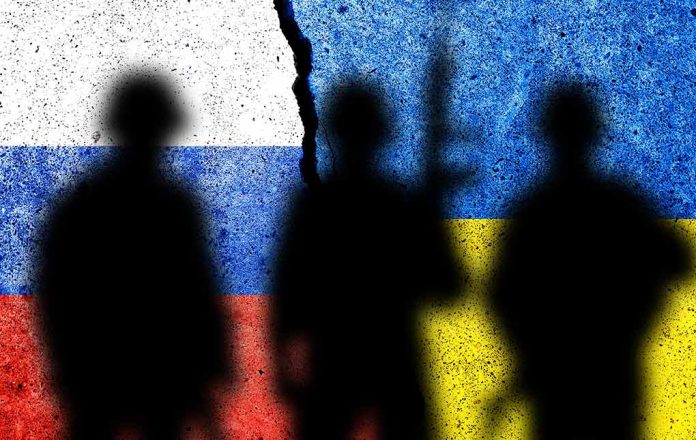
Russia demands NATO withdraw from the Baltics to end the Ukraine war, signaling a major escalation in Kremlin demands that threatens to indefinitely prolong the devastating conflict.
Key Takeaways
- Russia’s Deputy Foreign Minister Sergei Ryabkov explicitly linked Ukraine peace negotiations to NATO withdrawal from Baltic states, significantly expanding Russia’s war aims
- NATO is conducting extensive maritime exercises in the Baltic Sea with 17 countries and 50 vessels while Russia deploys a “ghost fleet” of vessels suspected of sabotage activities
- European NATO members must rapidly increase defense capabilities as US priorities shift toward the Indo-Pacific region
- Russia’s demands about NATO’s eastward expansion have escalated as Sweden and Finland abandoned neutrality to join the Alliance
- President Trump’s return to the White House has been cited by Russian officials as a “reason for cautious optimism” regarding potential diplomatic settlements
Russia Expands Demands Beyond Ukraine
Russian Deputy Foreign Minister Sergei Ryabkov has dramatically escalated the Kremlin’s demands for ending the Ukraine conflict. No longer limiting concerns to Ukraine’s NATO aspirations, Russia now insists the military alliance must withdraw completely from the Baltic states. This represents a significant expansion of Russia’s war aims, effectively holding peace hostage to concessions that would fundamentally alter European security architecture established since the Cold War’s end. The timing of these comments suggests Russia may be testing the resolve of Western allies as military aid to Ukraine faces increasing political challenges.
“The American side requires practical steps aimed at eliminating the root causes of the fundamental contradictions between us in the area of security. Among these causes, NATO expansion is in the foreground. Without resolving this fundamental and most acute problem for us, it is simply impossible to resolve the current conflict in the Euro-Atlantic region,” said Sergei Ryabkov.
Ryabkov’s comments reveal Moscow’s broader strategic objectives beyond the immediate battlefield in Ukraine. By framing the conflict as primarily about NATO’s eastward expansion rather than Ukraine’s sovereignty, Russia appears to be setting conditions that would effectively give it veto power over neighboring countries’ security arrangements. This position stands in stark contrast to NATO’s fundamental principle that sovereign nations have the right to choose their own security alliances. The demands regarding Baltic states—Estonia, Latvia, and Lithuania—are particularly provocative as these nations joined NATO in 2004 and have been steadfast Alliance members for two decades.
Baltic Sea Becomes Flashpoint for NATO-Russia Tensions
As diplomatic tensions escalate, the Baltic Sea has transformed into a theater of military posturing. NATO is currently conducting substantial maritime exercises involving 17 nations and approximately 50 vessels, led by the U.S. Navy’s 6th Fleet. The BALTOPS exercise aims to strengthen coordination among Baltic Sea nations while pointedly excluding Russia. These maneuvers occur against a backdrop of growing concern over Russia’s covert maritime activities, including suspected sabotage of undersea infrastructure critical to European communications and energy security.
“This year’s BALTOPS is more than just an exercise. It’s a visible demonstration of our Alliance’s resolve, adaptability and maritime strength,” said U.S. Vice Admiral J.T. Anderson.
Of particular concern is Russia’s deployment of what experts call a “ghost” or “shadow” fleet—aging vessels operating with minimal transparency and suspected of intelligence gathering and sabotage operations. This shadow fleet has gained increased attention after several incidents involving damaged undersea cables. Finnish authorities have charged three crew members from a Russian-linked vessel for damaging critical submarine infrastructure. The narrow waterways of the Baltic Sea, combined with heavy maritime traffic, create dangerous conditions where miscalculations could rapidly escalate into direct confrontation between nuclear powers.
NATO’s Shifting Defense Posture
NATO’s strategic position in Eastern Europe faces significant challenges as the alliance prepares for potential long-term confrontation with Russia. Currently, NATO’s defense capabilities in the region rely heavily on American military support, particularly in intelligence, surveillance, reconnaissance, and strategic capabilities. Defense analysts project that European NATO members must rapidly enhance their independent military capabilities, with a target of being able to defend the northeastern border without American assistance by 2027. This represents a fundamental shift in the alliance’s burden-sharing arrangements that have defined transatlantic security for decades.
“Russia has been and will likely remain a chronic threat to NATO,” said General Christopher Cavoli.
The strategic context is further complicated by shifting American priorities toward the Indo-Pacific region to counter Chinese influence, persistent Russian threats across multiple domains, and the growing partnership between Moscow and Beijing. European allies now face the dual challenge of rapidly rearming while avoiding strategies that could destabilize the continent. The war in Ukraine has strained NATO’s unity while simultaneously exposing critical weaknesses in Europe’s defense industrial base. Both American and European defense industries struggle with capacity and scalability issues that require bold solutions like modular production systems and enhanced cybersecurity.
Trump Administration and Prospects for Negotiation
Russian officials have made calculated statements regarding President Trump’s return to the White House, framing it as potentially positive for resolving the Ukraine conflict. Ryabkov specifically cited Trump’s commitment to diplomatic solutions as grounds for “cautious optimism” regarding potential normalization of relations. These comments suggest Moscow may be positioning itself for potential negotiations while simultaneously expanding its demands—a classic negotiating tactic of asking for far more than expected to secure lesser but still significant concessions during actual talks.
“Trump’s return to the White House, declaring his commitment to a political and diplomatic settlement of the Ukrainian crisis, has become a reason for cautious optimism in terms of a potential normalization of relations with the United States, but also in a broader sense,” said Sergei Ryabkov.
The conflict has taken on additional dimensions since Russia’s 2022 invasion, with Sweden and Finland abandoning decades of neutrality to join NATO—precisely the opposite outcome from what Russia claimed to want. This enlargement fundamentally alters the Baltic security landscape. Russia’s linking of the Ukraine conflict to broader NATO presence in the Baltics represents a significant escalation in diplomatic demands that seems designed to test Western resolve. For the Trump administration, navigating these demands while maintaining NATO cohesion and supporting Ukraine’s sovereignty will require extraordinary diplomatic skill to avoid either capitulation or further escalation.









